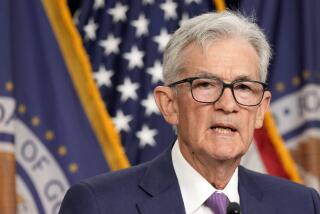Bush Adviser Favors Fed Action to Lower Interest Rates if Economy Falters
- Share via
WASHINGTON — President Bush’s chief economist Thursday urged the Federal Reserve Board to move quickly to lower interest rates if the economy fails to sustain its current pace.
“My own personal view is, if there (are) signs of softness in the economy from where we are now, that further easing would probably be appropriate,” said Michael J. Boskin, chairman of the White House Council of Economic Advisers.
Although the Fed began easing its grip on credit in early June, it recently stopped nudging interest rates down amid signs that the economy is expanding at a more vigorous pace than previously thought. The goal of Fed policy has been to achieve a “soft landing” in which growth slows enough to restrain inflation but remains strong enough to avoid a recession.
At a conference last week in Jackson Hole, Wyo., several members of the Fed’s policy-making committee expressed doubts about further lowering of interest rates, arguing that excessive economic growth threatens to undermine their anti-inflation efforts.
“The risk of recession in the second half (of 1989) has diminished substantially,” said Roger Guffey, president of the Federal Reserve Bank of Kansas City. “The risk is an accelerating growth.”
Ready to Blame Fed
But Boskin warned that the Fed’s goal of modest growth may not be good enough for the Administration. “We would not be satisfied with a definition of ‘soft landing’ that merely avoids a recession,” Boskin said in a speech at the U.S. Chamber of Commerce.
The Bush Administration remains worried that the Fed’s previous credit tightening, which pushed up short-term interest rates by about three percentage points from early 1988 to the middle of this year, might slow the economy too much. That, in turn, could make it impossible for the White House to achieve its deficit-cutting goals next year without a tax increase.
White House officials have also made it clear that they are prepared to blame the Fed publicly if the economy falls into a recession.
Last month, Richard G. Darman, director of the White House Office of Management and Budget, opened the latest round of Administration attacks on the Fed, asserting that the central bank “may have been a little bit too tight” in its recent credit policy. “If we do have a recession,” he said, “I think it will be because they erred on the side of caution.”
Darman found himself on the defensive after his sharp comments, particularly because new data suggested that fears of an economic downturn or a significant slowdown had been exaggerated.
In contrast to Darman, Boskin backed away from tough criticism of the Fed, suggesting only that it is still too early to judge the effects of recent monetary policy moves. “Picking fights between the Administration and the Fed is the best game in town and I don’t intend to get involved,” Boskin said.
In trying to keep inflation under control without plunging the economy into a recession, the Fed has “done a pretty good job so far,” Boskin said, “but we don’t really know what the final effects of that will be for some time.”
But Boskin, without citing the Fed by name, accused monetary officials of being too pessimistic about the growth potential of the economy.
Citing recent revisions of economic data showing labor productivity to be somewhat stronger than originally reported, Boskin said the new information backs up the Administration’s belief that the economy should be able to achieve an average growth rate of at least 3%. He contrasted that with a “more pessimistic forecast relied on by another branch of government.”
Most Fed officials, according to congressional testimony by Fed Chairman Alan Greenspan, believe that the economy cannot grow much faster than 2% to 2.5% a year without threatening to revive inflationary forces.
Generally Upbeat
The Federal Reserve, which is responsible for controlling the creation of money and credit and regulating the banking system, enjoys a quasi-independent status in the federal government. Established by Congress in 1913, the Fed is run by a seven-member board of governors appointed by the White House, subject to confirmation by the Senate. Its 12 regional bank presidents, who cast a combined total of five votes in monetary policy decisions, are chosen separately by Fed officials.
Boskin, in his speech, generally was upbeat about prospects for the economy, predicting that growth would pick up speed by the middle of next year. He cited a number of “remarkable economic achievements” of the 1980s and said policy-makers should be “ambitious” in setting goals for the economy.
More to Read
Get the L.A. Times Politics newsletter
Deeply reported insights into legislation, politics and policy from Sacramento, Washington and beyond. In your inbox three times per week.
You may occasionally receive promotional content from the Los Angeles Times.










